Explore the universe and discover our home planet with the official NASA Tumblr account
1K posts
Latest Posts by nasa - Page 15
Are there any parts of the Earth still left unexplored?
Is Earth your favorite planet? Why or why not?
Is earth doing fine, I'm afraid of all the bad stuff that's happening. I just wanna know if it's doing okay (◍•﹏•)
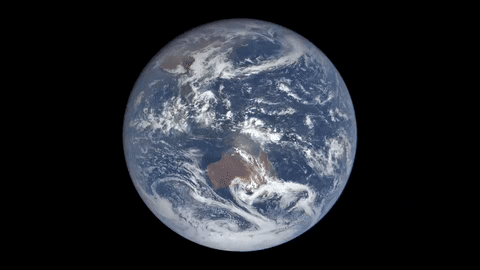
Happy 50th Anniversary of Earth Day! 💙🌍
We’re so glad you could join us for this special Earth edition of Tumblr Answer Time. Today is a perfect day to learn about our home planet directly from the people who work to keep it safe.
Kick off starts NOW!
Our Acting Director of Earth Sciences, Sandra Cauffman, and Associate Administrator for the Science Mission Directorate, Dr. Thomas Zurbuchen have answers to your questions from their homes! Enjoy.
Make sure to follow us on Tumblr for your regular dose of space: http://nasa.tumblr.com.
Looking 50 Years in the Future with NASA Earth Scientists
In the 50 years since the first Earth Day, the view from space has revolutionized our understanding of Earth’s interconnected atmosphere, oceans, freshwater, ice, land, ecosystems and climate that have helped find solutions to environmental challenges.
If NASA’s Earth science has changed this much in 50 years, what will it look like in 50 more years?
We asked some researchers what they thought. Here are their answers, in their own words.

Mahta Moghaddam is a professor of electrical and computer engineering at the University of Southern California. She’s building a system that helps sensors sync their measurements.
I am interested in creating new ways to observe the Earth. In particular, my team and I are building and expanding a system that will allow scientists to better study soil moisture. Soil moisture plays a vital role in the water and energy cycle and drives climate and weather patterns. When soil is wet and there is enough solar radiation, water can evaporate and form clouds, which precipitate back to Earth. Soil also feeds us – it nourishes our crops and sustains life on Earth. It’s one of the foundations of life! We need to characterize and study soil in order to feed billions of people now and in the future.

Our novel tool aims to observe changes in soil moisture using sensors that talk to each other and make decisions in real time. For instance, if one sensor in a crop field notes that soil is dry in a plot, it could corroborate it with other sensors in the area and then notify a resource manager or decision maker that an area needs water. Or if a sensor in another location senses that soil moisture is changing quickly due to rain or freeze/thaw activity, it could send a command to launch a drone or even to notify satellites to start observing a larger region. We live in one big, connected world, and can and will use many different scales of observations – local to global – from point-scale in-situ sensors to the scales that can be covered by drones, airplanes, and satellites. In just a few years from now, we might see much more vastly automated systems, with some touching not only Earth observations, but other parts of our lives, like drone deliveries of medical tests and supplies.

Odele Coddington is a scientist at the Laboratory for Atmospheric and Space Physics at the University of Colorado, Boulder. She’s building an instrument to measure how much solar energy Earth reflects back into space.
My research is focused on the Earth system response to the Sun’s energy. I spend half of my time thinking about the amount and variability of the Sun’s energy, also known as the solar irradiance. I’m particularly interested in the solar spectral irradiance, which is the study of the individual wavelengths of the Sun’s energy, like infrared and ultraviolet. On a bright, clear day, we feel the Sun’s warmth because the visible and infrared radiation penetrate Earth’s atmosphere to reach the surface. Without the Sun, we would not be able to survive. Although we’ve been monitoring solar irradiance for over 40 years, there is still much to learn about the Sun’s variability. Continuing to measure the solar irradiance 50 years from now will be as important as it is today.

I spend the other half of my time thinking about the many processes driven by the Sun’s energy both within the atmosphere and at the surface. I’m excited to build an instrument that will measure the integrated signal of these processes in the reflected solar and the emitted thermal radiation. This is my first foray into designing instrumentation and it has been so invigorating scientifically. My team is developing advanced technology that will measure Earth’s outgoing radiation at high spatial resolution and accuracy. Our instrument will be small from the onset, as opposed to reducing the size and mass of existing technology. In the future, a constellation of these instruments, launched on miniaturized spacecraft that are more flexible to implement in space, will give us more eyes in the sky for a better understanding of how processes such as clouds, wildfires and ice sheet melting, for instance, alter Earth’s outgoing energy.

Sujay Kumar is a research physical scientist at NASA’s Goddard Space Flight Center. He works on the Land Information System.
Broadly, I study the water cycle, and specifically the variability of its components. I lead the development of a modeling system called the Land Information System that isolates the land and tries to understand all the processes that move water through the landscape. We have conceptual models of land surface processes, and then we try to constrain them with satellite data to improve our understanding. The outputs are used for weather and climate modeling, water management, agricultural management and some hazard applications.

I think non-traditional and distributed platforms will become more the norm in the future. So that could be things like CubeSats and small sats that are relatively cheaper and quicker than large satellites in terms of how much time it takes to design and launch. One of the advantages is that because they are distributed, you’re not relying on a single satellite and there will be more coverage. I also think we’ll be using data from other “signals of opportunity” such as mobile phones and crowd-sourced platforms. People have figured out ways to, for example, retrieve Earth science measurements from GPS signals.
I feel like in the future we will be designing our sensors and satellites to be adaptive in terms of what the observational needs on the ground are. Say a fire or flood happens, then we will tell the satellite to look over there more intensely, more frequently so that we can benefit. Big data is a buzzword, but it’s becoming a reality. We are going to have a new mission call NISAR that’s going to collect so much data that we really have to rethink how traditional modeling systems will work. The analogy I think of is the development of a self-driving car, which is purely data driven, using tons and tons of data to train the model that drives the car. We could possibly see similar things in Earth science.
Hear from more NASA scientists on what they think the future will bring for Earth science:
Make sure to follow us on Tumblr for your regular dose of space: http://nasa.tumblr.com.
Earth Day at Home with NASA
When you think about Earth Day, you might think about planting trees or picking up garbage. But right now, as a lot of us are staying inside to stay safe, we’ve got you covered for Earth Day at Home with ways to appreciate our beautiful home planet from your couch.
Want to help our researchers map coral in the ocean?
Our new NeMo-Net app lets you do that while playing a game!

What about virtually exploring our planet?
Worldview lets you choose any location on Earth and see it the way our satellites do – in natural color, lit by electric lights at night, or in infrared, highlighting fires around the globe.

On April 22 -- Earth Day -- we’ll have a host of activities you can participate in. Scientists will share their research from their own homes, including messages from astronauts living on the International Space Station! Hear stories from a trip to Earth’s most remote location: Antarctica, including what happens when the chocolate goes missing on a weeks-long excursion. We’ll even have a new episode of NASA Science Live sharing some of what we’re doing to make our work more sustainable.

We’ll be sharing Earth Day from our homes with #EarthDayAtHome on Twitter, Instagram, Facebook and with a Tumblr Answer Time right here! Follow along, and participate, as we share our love for our home planet with you.
Make sure to follow us on Tumblr for your regular dose of space: http://nasa.tumblr.com.

Photograph of the Apollo 13 Spacecraft Being Returned to the Prime Recovery Ship, USS Iwo Jima, 4/17/1970
Series: Color Photograph Files, 1965 - 2002. Record Group 255: Records of the National Aeronautics and Space Administration, 1903 - 2006.
Apollo 13 was intended to be the third Apollo mission to land on the Moon. The craft was launched from Kennedy Space Center in Merritt Island, Florida on April 11, 1970. Two days into the flight, damaged wire insulation inside the oxygen tank in the service module ignited, causing an explosion which vented the oxygen tank into space. Without oxygen, the service module became inoperable and the lunar mission quickly turned into a mission to safely return the crew to Earth. The astronauts worked with Mission Control to shut down the command module in order to conserve the remaining oxygen, forcing all three astronauts into the lunar module. The astronauts continued to work with Mission Control to combat one technical failure after another until, on April 17, 1970, the crew landed safely in the South Pacific Ocean.
source: phillyarchives.tumblr.com

Participate in the 50th anniversary of Earth Day by asking our experts anything about NASA’s role in Earth Science!
This year marks the 50th anniversary of Earth Day, and to commemorate the big day we’re bringing you exclusive access our Acting Director of Earth Sciences, Sandra Cauffman, and Associate Administrator for the Science Mission Directorate, Dr. Thomas Zurbuchen! They will be teaming up to take your questions in an Answer Time session on Earth Day, April 22, from 12-1pm EDT here on NASA’s Tumblr! Make sure to ask your question now by visiting http://nasa.tumblr.com/ask!
Our investment in space – both the unique Earth science we conduct from orbit and the technology we’ve developed by living in space and exploring our solar system and universe – is returning benefits every day to people around the world, particularly those who are working on environmental issues. From documenting Earth’s changing climate to creating green technologies to save energy and natural resources, we’re working to help us all live more sustainably on our home planet and adapt to natural and human-caused changes.

NASA Earth Science Fun Facts!
From space we study: dust storms, volcanoes, flooding, coral reefs, night lights, wildfires, urban growth, food production, mosquito tracking and other human health issues, precipitation across the world, hurricanes and typhoons, soil moisture, land and sea ice, and changes to the land and sea surfaces.
From airborne research planes we track: changes in polar ice, glaciers, sea level rise, cloud formation, storms, sea level rise and Earth’s changing landscape.
Our Earth science focus areas include: Atmospheric Composition, Weather and Atmospheric Dynamics, Climate Variability and Change, Water and Energy Cycle, Carbon Cycle and Ecosystems, Earth Surface and Interior
Keep up to date with all our Earth Science missions and research by following NASA Earth on Twitter, Facebook and Instagram.
Make sure to follow us on Tumblr for your regular dose of space: http://nasa.tumblr.com.
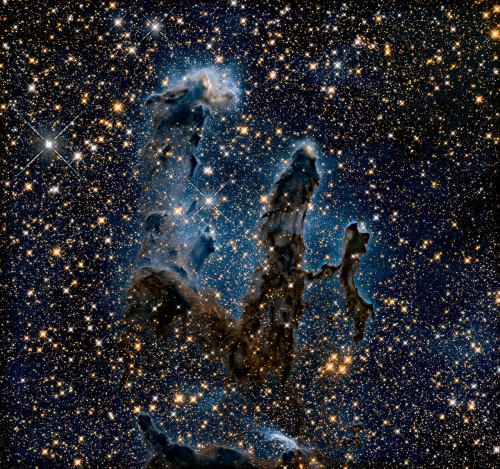
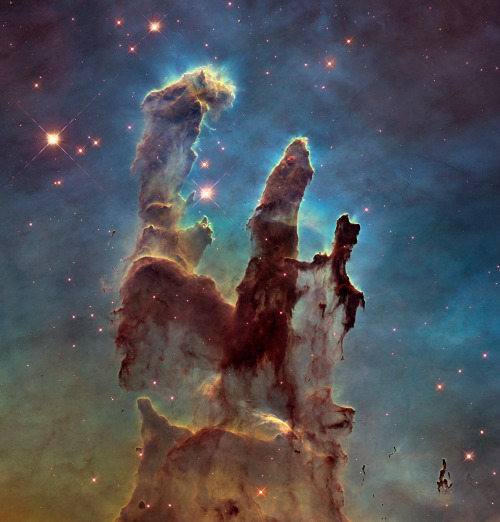
Sometimes... there’s more than meets the eye. 👀 You’re looking at two very different takes on an iconic image.
Human eyes can see only a small portion of the range of radiation given off by the objects around us. We call this wide array of radiation the electromagnetic spectrum, and the part we can see visible light.
In the first image, researchers revisited one of Hubble Space Telescope’s most popular sights: the Eagle Nebula’s Pillars of Creation. Here, the pillars are seen in infrared light, which pierces through obscuring dust and gas and unveil a more unfamiliar — but just as amazing — view of the pillars. The entire frame is peppered with bright stars and baby stars are revealed being formed within the pillars themselves. The image on the bottom is the pillars in visible light.
Image Credit: NASA, ESA/Hubble and the Hubble Heritage Team
Make sure to follow us on Tumblr for your regular dose of space: http://nasa.tumblr.com.
You’ve Heard “Houston, we’ve had a problem,” But Do You Know The Mission It’s From?
It’s the 50th anniversary of the Apollo 13 mission! NASA’s “successful failure,”Apollo 13 was to be the third lunar landing attempt, but the mission was aborted mid-flight after the rupture of a service module oxygen tank. The crew never landed on the moon, but due to the dedication and ingenuity of Mission Control, made it back to Earth safely. We’ve put some of the most important numbers of the Apollo 13 mission in perspective. Check it out!









Listen to the mission in real time, HERE.
Follow NASA History on Twitter and Facebook for more interesting information about aerospace history!
Check out the stats of all the Apollo Missions in the free e-book Apollo by the Numbers, HERE.
Want to Help Save Earth’s Coral Reefs? Here’s Your Chance
Coral reefs are one of the most diverse ecosystems on the planet. They’re also in serious danger. Rising ocean temperatures, pollution and other threats are pushing corals towards extinction. But there’s hope. Using techniques originally developed to look at the stars, a team of scientists at our Ames Research Center in California’s Silicon Valley have developed a way to image corals in unprecedented detail. Now, the same team has launched a citizen science project, called NeMO-Net, to classify and assess the health of coral reefs across the globe.

NeMO-Net is a coral classification game that lets you embark on a virtual research vessel and travel the oceans, analyzing actual images of corals on the sea floor. As you explore, you learn about the different types of corals and how to identify them. Your actions in-game train a supercomputer in the real world to classify corals on its own. Each classification you make will help researchers better understand how coral reefs are changing, and ultimately, find a way to save these amazing underwater worlds. Ready to play? Here’s a quick guide to getting started:
Download NASA NeMO-Net

Explore 3D images of the sea floor

Learn about the different types of corals

Identify and classify corals by painting images

Gain experience points, track your progress and be part of a global community of citizen scientists

NeMO-Net is available now on the Apple App Store, and is playable on iOS devices and Mac computers, with a forthcoming release for Android systems.
Make sure to follow us on Tumblr for your regular dose of space: http://nasa.tumblr.com.
Tournament Earth: The Earthly Eight
To celebrate Earth Observatory’s 20th anniversary and the 50th anniversary of Earth Day, we asked readers to pick our all-time best image. We have already completed two rounds of voting, which led to two rounds of stunning upsets. As we head into round 3, only two of the top eight seeds (#1s and #2s) remain. It is time now to cast your votes for the best of the Earthly 8. Voting ends on April 13 at 9 a.m. U.S. Eastern Time.
The nominees are separated into four groups: Past Winners, Home Planet, Land & Ice, and Sea & Sky. Check out the contenders still in the game:
Past Winners: Ocean Sand, Bahamas (#5 seed) vs. A View from Saturn (#2 seed)
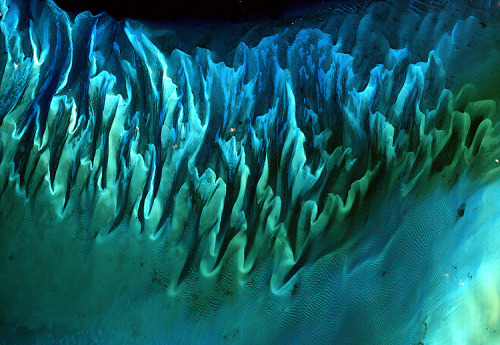
Though the above image may resemble a new age painting straight out of an art gallery in Venice Beach, California, it is in fact a satellite image of the sands and seaweed in the Bahamas. The image was taken by the Enhanced Thematic Mapper plus (ETM+) instrument aboard the Landsat 7 satellite. Tides and ocean currents in the Bahamas sculpted the sand and seaweed beds into these multicolored, fluted patterns in much the same way that winds sculpted the vast sand dunes in the Sahara Desert.

This beautiful image of Saturn and its rings looks more like an artist’s creation than a real image, but in fact, the image is a composite (layered image) made from 165 images taken by the wide-angle camera on the Cassini spacecraft over nearly three hours on September 15, 2006. Scientists created the color in the image by digitally compositing ultraviolet, infrared, and clear-filter images and then adjusting the final image to resemble natural color. (A clear filter is one that allows in all the wavelengths of light the sensor is capable of detecting.) This image is a closeup view of the upper left quadrant of the rings, through which Earth is visible in the far, far distance. The full image can be seen here.
Home Planet: Twin Marbles (#1 seed) vs. Fire in the Sky and on the Ground (#7 seed)

A day’s clouds. The shape and texture of the land. The living ocean. City lights as a beacon of human presence across the globe. This amazingly beautiful view of Earth from space is a fusion of science and art, a showcase for the remote-sensing technology that makes such views possible, and a testament to the passion and creativity of the scientists who devote their careers to understanding how land, ocean, and atmosphere—even life itself—interact to generate Earth’s unique (as far as we know!) life-sustaining environment.

Astronauts on the International Space Station (ISS) used a digital camera to capture several hundred photographs of the aurora australis, or “southern lights,” while passing over the Indian Ocean on September 17, 2011. If you click on this movie, you can see the flowing ribbons and rays below as the ISS passed from south of Madagascar to just north of Australia between 17:22 and 17:45 Universal Time. Solar panels and other sections of the ISS fill some of the upper right side of the photograph.
Auroras are a spectacular sign that our planet is electrically and magnetically connected to the Sun. These light shows are provoked by energy from the Sun and fueled by electrically charged particles trapped in Earth’s magnetic field, or magnetosphere. In this case, the space around Earth was stirred up by an explosion of hot, ionized gas from the Sun—a coronal mass ejection—that left the Sun on September 14, 2011.
Ice and Land: Sand Dunes (#8 seed) vs. Retreat of Columbia Glacier (#6 seed)

Mountains of sand, some as tall as 300 meters (1000 feet), reach from the floor of Africa’s Namib Desert toward the sky. Driven by wind, these dunes march across the desert, bordered to the west by the Atlantic Ocean and in other directions by solid, rocky land.
The abrupt transition from sand to land is visible in this image, acquired on November 13, 2019, by the Operational Land Imager (OLI) on Landsat 8. They show the northern extent of the Namib Sand Sea—a field of sand dunes spanning more than 3 million hectares (more than 10,000 square miles) within the Namib-Naukluft Park, which was named a UNESCO World Heritage site in 2013. Sand appears red, painted by a layer of iron oxide.


Scientists have long studied Alaska's fast-moving Columbia Glacier, a tidewater glacier that descends through the Chugach Mountains into Prince William Sound. Yet the river of ice continues to deliver new surprises.
The image series begins in July 1986 (bottom image) with a false-color image captured by the Thematic Mapper (TM) sensor on the Landsat 5 satellite. The false-color image from July 2014 (top image), acquired by the Operational Land Imager on the Landsat 8 satellite, shows the extent of retreat after 28 years. Use the image comparison tool to better see the details.
Sea and Sky: Atafu Atoll, Tokelau (#8 seed) vs. Raikoke Erupts (#6 seed)

At roughly eight kilometers wide, Atafu Atoll is the smallest of three atolls and one island (Nukunonu and Fakaofo Atolls to the southeast and Swains Island to the south are not shown) comprising the Tokelau Islands group located in the southern Pacific Ocean. The primary settlement on Atafu is a village located at the northwestern corner of the atoll. The typical ring shape of the atoll is the result of coral reefs building up around a former volcanic island.
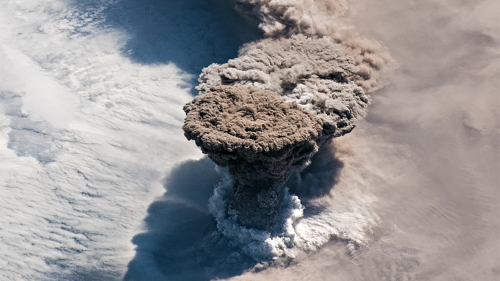
Unlike some of its perpetually active neighbors on the Kamchatka Peninsula, Raikoke Volcano on the Kuril Islands rarely erupts. The small, oval-shaped island most recently exploded in 1924 and in 1778.
The dormant period ended around 4:00 a.m. local time on June 22, 2019, when a vast plume of ash and volcanic gases shot up from its 700-meter-wide crater. Several satellites—as well as astronauts on the International Space Station—observed as a thick plume rose and then streamed east as it was pulled into the circulation of a storm in the North Pacific.
On the morning of June 22, astronauts shot this photograph of the volcanic plume rising in a narrow column and then spreading out in a part of the plume known as the umbrella region. That is the area where the density of the plume and the surrounding air equalize and the plume stops rising. The ring of clouds at the base of the column appears to be water vapor.
See all of the images and vote now HERE.
Make sure to follow us on Tumblr for your regular dose of space: http://nasa.tumblr.com.

Up for some virtual cloud watching? ☁️
What do you see in Jupiter's hazy atmosphere?
Our NASA JunoCam mission captured this look at the planet’s thunderous northern region during the spacecraft’s close approach to the planet on Feb. 17, 2020.
Some notable features in this view are the long, thin bands that run through the center of the image from top to bottom. Juno has observed these long streaks since its first close pass by Jupiter in 2016.
Image Credits: Image data: NASA / JPL / SwRI / MSSS Image Processing: Citizen Scientist Eichstädt
Make sure to follow us on Tumblr for your regular dose of space: http://nasa.tumblr.com.
Sit Back and Space Out
Peer out on the depths of universe from the cupola windows,
Meander through the hallways of space,
Float in the home office of the star sailors.
Allow yourself to - space out - and imagine life through the eyes of NASA Astronauts on the International Space Station.
Check out other ways to enjoy #NASAatHome, HERE. We've curated videos, activities and fun in one out-of-this world place.
Make sure to follow us on Tumblr for your regular dose of space: http://nasa.tumblr.com.
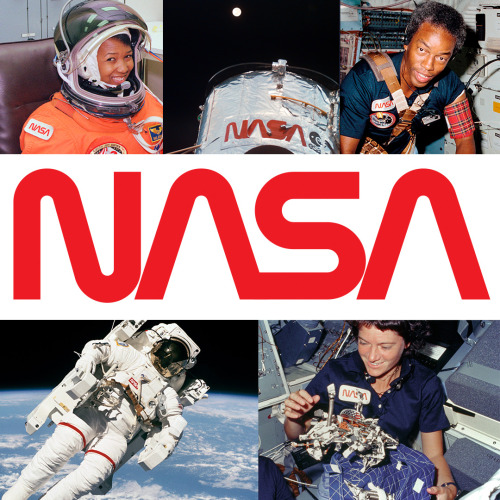
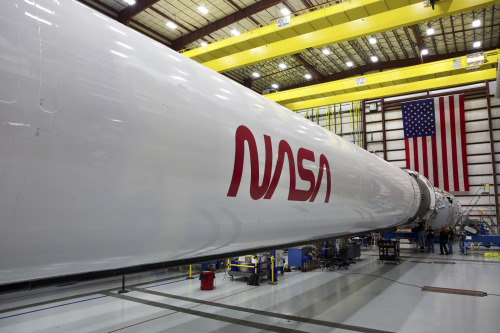
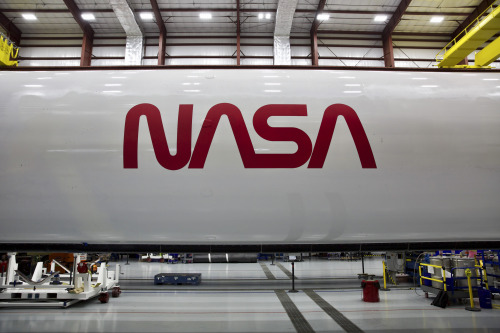
Retro. Modern. Iconic. That’s the worm.
#TheWormIsBack
Our beloved symbol of exploration will fly once again, just in time to mark the return of human spaceflight on American rockets from American soil. The retired logo is making its comeback on on SpaceX’s Falcon 9 rocket that will take flight later this year when we #LaunchAmerica once again.
The NASA insignia, or "meatball," seen in our profile image, was quite difficult to reproduce with 1970s technology. In 1975, enter the sleek, simple design you see above! The world knew it as “the worm.” For a period of time we were able to thrive with both the worm and the meatball. However, in 1992, the 1970s brand was retired - except on clothing and other souvenir items - in favor of the original late 1950s graphic.
Image Credit: NASA/SpaceX
Make sure to follow us on Tumblr for your regular dose of space: http://nasa.tumblr.com.
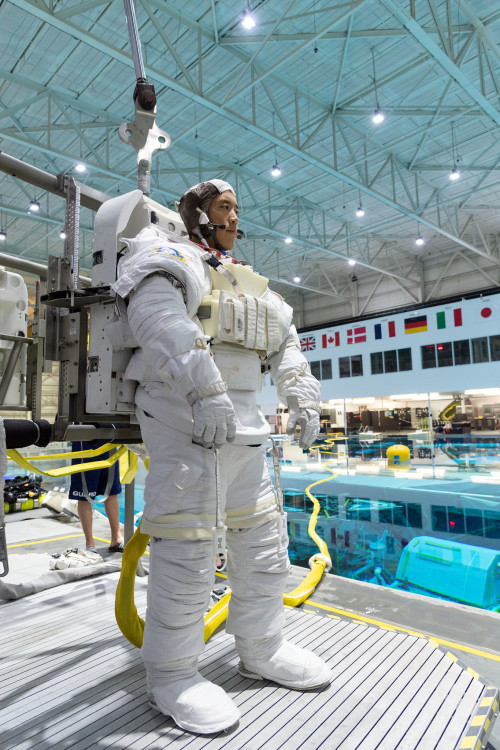
NASA Spotlight: Astronaut Jonny Kim
Dr. Jonny Kim was selected by NASA to join the 2017 Astronaut Candidate Class. He reported for duty in August 2017 and having completed the initial astronaut candidate training is now eligible for mission assignments to the International Space Station, the Moon and eventually Mars. A U.S. Navy SEAL, Kim completed more than 100 combat operations. Kim was commissioned as a naval officer through an enlisted-to-officer program and earned his degree in mathematics at the University of San Diego and a doctorate of medicine at Harvard Medical School. Born and raised in Los Angeles, California to Korean-American immigrants, he enjoys spending time with his family, outdoor activities, academic and professional mentoring, strength training and lifelong learning.
Dr. Kim took some time from his job as a NASA astronaut to answer questions about his life and career! Enjoy:
Why did you apply to be an astronaut?
For many reasons. I think that humans are natural explorers. There is a calling in all of us to explore the unknown, push the boundaries and redefine what is possible. I’m drawn to the physical and mental challenges of space exploration and the teamwork required to complete such an objective. And finally, the opportunity to do something good for our country, for humanity, and to inspire the next generation of thinkers, leaders, explorers and scientists.
What was your favorite memory from astronaut training?

I’m a big believer that people can grow stronger bonds with each other when they succeed through shared hardship. And I think that developing relationships with one another is one of the best ways to forge successful team skills to be successful in any endeavor. With that context, I can tell you that my favorite memory from astronaut training was traversing the deep canyon slots of the Utah Canyon Lands for almost 2 weeks with my classmates. We hiked trails, climbed canyons, swam through deep, dark, cold and murky waters and forged through uncertainty, all while being together. This shared hardship was not only fun, but it helped us grow closer to one another. It’s one of the fondest memories I have when I think about my amazing classmates, and through that shared hardship, I know I can count on any one of my fellow astronauts when the going gets tough.
If you could play any song during launch, what would it be?
Don’t Stop Believin’ by Journey.
What advice would you give to your younger self?
I would tell myself to always follow your passion, never stature or money, because following a life of passion is long-term, sustainable and usually helps others. Be accountable for your mistakes and failures, and maintain the humility to learn from those mistakes and failures. And finally, I would caution myself that all worthwhile goals are difficult to obtain, but with the right attitude and hard work, you can accomplish anything.
How did your time as a Navy Seal impact your astronaut training?

Being a Naval Special Warfare Operator taught me that humans are capable of accomplishing ten times what their bodies and mind tell them. I learned there are no limits in life, and the biggest setback one can have is a poor attitude. I learned the value of strong leadership and accountability. I also learned the meaning of sacrifice, hardship, teamwork, love and compassion. All these traits helped me to develop the hard and soft skills required to be an astronaut.
How do we prepare medically for long duration missions? What tools, resources, medications do we anticipate needing, and how do we figure that out?
This is a great question and the answer is evolving. The way we answer this question is by being thoughtful and consulting the medical communities to weigh the pros and cons of every single decision we make regarding this. Mass plays an important factor, so we have to be mindful of everything we bring and how we train for it.
Who was the first person you called after being selected to be an astronaut?

It would have been my wife but she was with me when I heard the news. The first person I called was my mom.
What is one item from home that you would bring to space?
A picture of my wife and kids.
What does it mean to you to be part of the Artemis generation of astronauts?

It means that I have a duty and obligation to serve humanity’s best interests. To explore the unknown, push boundaries and redefine what’s possible. It means I have an immense opportunity to serve as an example and inspiration to our next generation of leaders and explorers. It also means there is a hard road ahead, and when the mission calls for us, we will be ready.
What are three personal items, besides photos of family and friends, that you would bring with you on your first spaceflight?
An automatic watch, because the engineering behind a timepiece is a beautiful thing. An American flag, because I proudly believe and uphold the principles and ideals our country stands for. And finally, a nice journal that I can put handwritten thoughts on.
Thank you for your time, and good luck on your first spaceflight assignment!
Follow Jonny Kim on Twitter and Instagram to keep up with his life as NASA astronaut.
It’s not too late to APPLY to #BeAnAstronaut! Applications close TOMORROW, March 31.
Make sure to follow us on Tumblr for your regular dose of space: http://nasa.tumblr.com.
Choose Your Champion: Tournament Earth 2020
Tournament Earth is here! We want YOU to help us choose our best Earth image.

Since 1999, NASA Earth Observatory has published 16,000+ images. To celebrate our 20th anniversary and the 50th anniversary of Earth Day, we want you to pick our all-time best image. Each week from March 23 to April 28, you can vote for your favorite images. Readers will narrow the field from 32 nominees down to one champion in a five-round knockout-style tournament.
The nominees are separated into four groups: Past Winners, Home Planet, Land & Ice, and Sea & Sky.
Past Winners

No, that is not an animation of the death star orbiting Earth. It is the winner of Tournament Earth in 2016– the Dark Side and the Bright Side. The image shows the fully illuminated far side of the Moon that is not visible from Earth. Other contenders in this category are a picture of a volcanic eruption plume, sands and seas in the Bahamas, and lightning seen from the Space Station.
Home Planet

This picture of the Twin Blue Marbles is the number one seed in our "Home Planet" category, but that doesn't mean it's going to take home the crown. It has stiff competition from the iconic photo of Earth rising to an epic total solar eclipse to our Earth at night.

Land & Ice

Are you a land lover or ice lover? If you don't know, you might found out by browsing the beautiful imagery in this category. Vote on scenes from the partially frozen North Caspian Sea (above) to lava flowing in Iceland between the Bardarbunga and Askja volcanoes (below).

Sea & Sky

Hurricanes, lightning, and volcanic explosions are just a few of the amazing captures from NASA satellites and astronauts in this category.
The model-based visual above shows an expansive view of the mishmash of particles that dance and swirl through the atmosphere. It shows tropical cyclones, dust storms, and fires spreading tiny particles throughout the atmosphere during one day in August 2018.

Our satellites also capture the fine mixing of particles and churning of tides in our rivers. The image above shows dissolved organic matter from forests and wetlands that stained the water dark brown near Rupert Bay. A similar process darkens tea.
Learn more about Tournament Earth in the video below.
See all of the images and vote now HERE.
Make sure to follow us on Tumblr for your regular dose of space: http://nasa.tumblr.com.
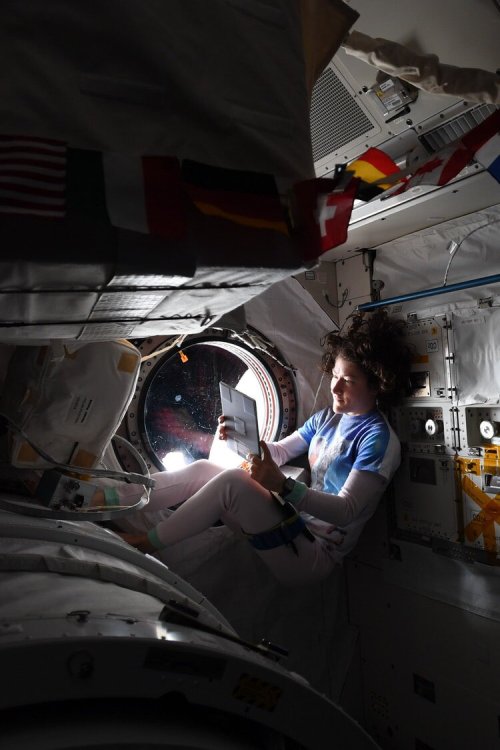
Introducing Astronaut Story Time – from Earth! 📖
Tomorrow and each weekday at 4 p.m. EDT, record-breaking astronaut Christina Koch, who recently returned to our home planet after 328 days in space, will read a children’s book on HER Instagram Live!
👉🏽Follow @Astro_Christina to enjoy #NASAatHome ⏰Tap our story on Instagram to set a reminder to tune in If you want to learn more about life as one of our @NASAastronauts or you want to apply to #BeAnAstronaut, click HERE. Applications close in 5 days.
Make sure to follow us on Tumblr for your regular dose of space: http://nasa.tumblr.com.

If we could squeeze a galaxy, it would be this fluffy-looking one.
Spiral galaxies like this, located 60 million light-years away, have supermassive black holes at their bright centers. Astronomers are trying to understand this cozy relationship.
Make sure to follow us on Tumblr for your regular dose of space: http://nasa.tumblr.com.
An Astronaut’s Tips For Living in Confined Spaces
One thing astronauts have to be good at: living in confined spaces for long periods of time.

Nearly 20 years successfully living on the International Space Station and more than 50 flying in space did not happen by accident. Our astronauts and psychologists have examined what human behaviors create a healthy culture for living and working remotely in small groups. They narrowed it to five general skills and defined the associated behaviors for each skill.
For many of us in a similar scenario, here are the skills as shared by astronaut Anne McClain:
Skill 1, Communication

Share information and feelings freely.
Talk about your intentions before taking action.
Discuss when your or others’ actions were not as expected.
Take time to debrief after success or conflict.
Admit when you are wrong.
Skill 2, Self-Care

Balance work, rest, and personal time. Be organized.
Realistically assess your own strengths and weaknesses, and their influence on the group.
Identify personal tendencies and their influence on your success or failure. Learn from mistakes.
Be open about your weaknesses and feelings.
Take action to mitigate your own stress or negativity (don't pass it on to the group).
Skill 3, Team Care

Demonstrate patience and respect. Encourage others.
Monitor your team (or friends and family) for signs of stress or fatigue.
Encourage participation in team (or virtual) activities.
Volunteer for the unpleasant tasks. Offer and accept help.
Share credit; take the blame.
Skill 4, Group Living

Cooperate rather than compete.
Actively cultivate group culture (use each individual's culture to build the whole).
Respect roles, responsibilities and workload.
Take accountability; give praise freely. Then work to ensure a positive team attitude.
Keep calm in conflict.
Skill 5, Leadership/Followership

Accept responsibility.
Adjust your style to your environment.
Assign tasks and set goals.
Lead by example. Give direction, information, feedback, coaching and encouragement.
Talk when something isn’t right. Ask questions.
We are all in this together on this spaceship we call Earth! These five skills are just reminders to help cultivate good mental and physical health while we all adjust to being indoors. Take care of yourself and dive deeper into these skills HERE.
Make sure to follow us on Tumblr for your regular dose of space: http://nasa.tumblr.com.




To all those looking to the stars, believe in yourself – we do. ❤️ From auto mechanic to geologist - everyone's story is different. Our NASA astronauts come from all walks of life, with backgrounds as unique as the individuals themselves. Get to know their stories and even apply to #BeAnAstronaut, HERE. Applications close March 31.
Make sure to follow us on Tumblr for your regular dose of space: http://nasa.tumblr.com.
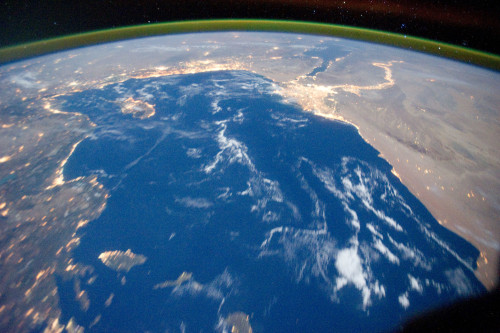
“Only in the darkness can you see the stars.” —Martin Luther King, Jr. Pause for a moment and take in the vastness and beauty of our home planet captured from the vantage point of space. On this spaceship we call Earth, we are all in this together. 💙
Make sure to follow us on Tumblr for your regular dose of space: http://nasa.tumblr.com.
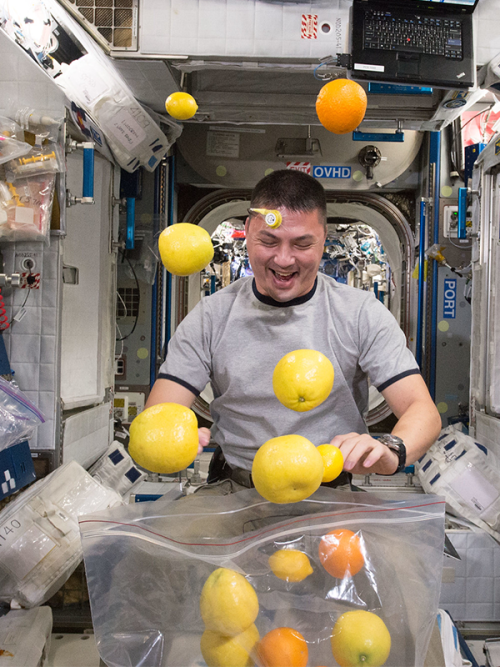
NASA Spotlight: Astronaut Kjell Lindgren
Kjell N. Lindgren was selected by NASA in 2009. Born in Taiwan while his family was stationed overseas, he spent most of his childhood abroad and returned to the U.S. to complete his education and earn a Doctorate of Medicine from the University of Colorado. He is board certified in emergency and aerospace medicine. After serving as the Deputy Crew Surgeon for Space Shuttle mission STS‐130 and Expedition 24, he was selected to join our astronaut corps. Dr. Lindgren flew on the International Space Station from July 2015 to December 2015 and logged 141 days in space. He participated in two spacewalks and in more than a hundred different scientific experiments. In his free time, Dr. Lindgren enjoys spending time with his family, running, reading, movies, photography and amateur astronomy.
He took some time from being a NASA astronaut to answer questions about his life and career! Enjoy:
What is one thing you would take to space that would make life easier?
A real R2 unit, of course! Just kidding, but in the future… Honestly though, life is pretty good on the International Space Station. While it is still a lot like camping (sleeping bags, no running water, rehydrated food) the space station team has really equipped us for success. As you all prepare for YOUR future spaceflight, I would say that the two most useful items I had with me on a daily basis were a pair of scissors and a spoon. The scissors were super useful for cutting plastic wrappers, tape, etc., and opening food packages (much more useful than a knife). And the spoon is the only utensil you need for eating – at least with the food system that we have right now.
Who helped get you to where you are?

Getting this opportunity, becoming an astronaut – that was a team effort for sure. I had so many people walking alongside me on this journey, helping me along the way. My parents set the bit early on – telling me that I could become whatever I wanted through hard work. They really gave me permission to dream big. Teachers and coaches, mentors, co-workers and friends all played a huge part in reaching this goal. Most of all, though, my wife, Kristi and my three kids have been an integral part of this adventure. I would not have this job, and I wouldn’t be successful in it without their love and daily support.
You and your crew mates were the first astronauts to harvest lettuce grown on orbit. How did it taste?

The lettuce tasted like…lettuce, which was a good thing, because if it hadn’t, then it meant we had made a huge mistake. It was so much fun to be a part of that experiment. The payoff, getting to eat fresh grown food on orbit was of course, a lot of fun. But just getting to take care of the lettuce plant, watch it grow in the sterile looking environment of the space station, getting to take care of this living thing on a daily basis, it was good for the soul.
How do you prepare for someone getting hurt or sick in space?
We train at least two crew members on every expedition to be Crew Medical Officers, or CMOs. They spend about 40 – 50 hours learning how to use the medical equipment and procedures on the space station, so that they can essentially serve as an extension of the flight surgeon in mission control. We have equipment and medication to deal with most minor illnesses and injuries. But because we are in low earth orbit, we can evacuate an ill crew member back to Earth in the event of a severe medical issue. This option won’t be available as we push out further from Earth, so we’ll need more rigorous training and a more comprehensive medical system.
How many times did you apply to be an astronaut?

I was very fortunate and got selected on my first try. I have several friends in the office though, who applied 4 or 5 times before being selected. It is amazing to go through the selection process and to meet others who share your dream. Enjoy the experience and keep applying – it is worth it!
How can I improve my chances of being selected to become an astronaut?
I recommend continuing to do things that you enjoy, continue to build experience at work and maybe look for new opportunities in your job that will grow you in your career and grow you as a leader. But choose opportunities because YOU want to do them, not based on what you think NASA is looking for. There is no one path or experience that leads to becoming an astronaut. We have an amazing diversity of experience and background in the astronaut office.
What advice do you have for the newest astronauts?

Enjoy the journey! Spaceflight is amazing, but even as astronauts, most of us spend 95% of our career on the ground. Enjoy every part of the job, supporting missions as a Spacecraft Communicator (CapCom), verifying procedures for a repair or training for a spacewalk. It is amazing to be a part of the team that launches and supports humans living and working in space. It is an amazing thing.
Which is more exciting: spacewalking or skydiving?

Skydiving was pretty amazing. I got to do quite a bit of it as a member of the Air Force Academy parachute team. But there is nothing quite like doing a spacewalk. It is an indescribable experience, putting hundreds of hours of training to work, the physical and mental challenge of operating in that harsh environment. But the view outside the space station, of the Earth, the stars, the structure of the space station – it was a highlight of my time in space and something I will never forget.
What's the most interesting part about training with the Dragon capsule?
It has been awesome working with the NASA and SpaceX teams as we are preparing to launch in the Crew Dragon capsule. My favorite part of the experience has always been and continues to be the people. Safely sending humans to space and back is one of the most difficult things humanity has ever done. That challenge attracts the best and brightest people from across our country. Getting to work with those folks at NASA and at SpaceX, to experience their enthusiasm, dedication and ingenuity on a daily basis is a gift. It has also been a lot of fun seeing a different approach to human spaceflight. I’m very familiar with how NASA and the Russian Space Agency Roscosmos operate. It has been fun seeing a different perspective and approach.
Can you share your favorite photo or video that you took in space?

Yes! This is my favorite photo of the Milky Way, with a lightning strike illuminating a solar array.
Thanks Dr. Lindgren, and good luck on your next spaceflight!
Make sure to follow us on Tumblr for your regular dose of space: http://nasa.tumblr.com.
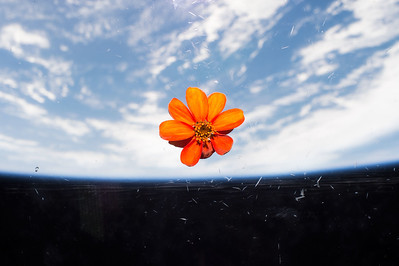
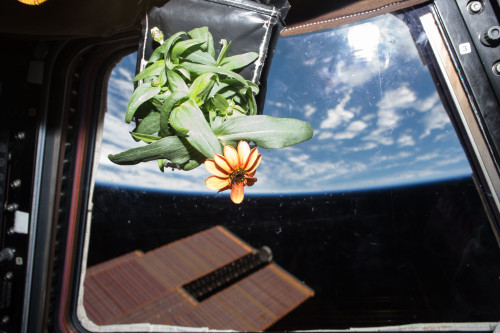
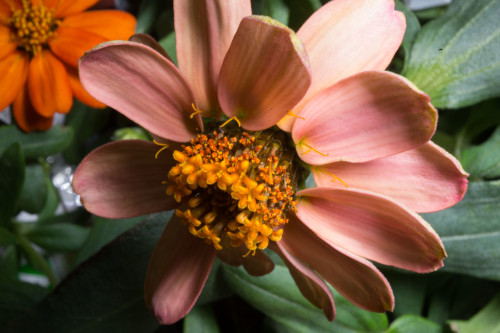
Take a moment, look outside your window. 🌷🌼
Today is the #FirstDayOfSpring in the Northern Hemisphere, also known as the vernal equinox.
#DYK Earth’s tilted axis causes the season? Throughout the year, different parts of Earth receive the Sun’s most direct rays. So, when the North Pole tilts toward the Sun, it’s summer in the Northern Hemisphere. And when the South Pole tilts toward the Sun, it’s winter in the Northern Hemisphere.
These images are of Zinnias. They are part of the flowering crop experiment that began aboard the International Space Station on Nov. 16, 2015, when NASA astronaut Kjell Lindgren activated the Veggie system and its rooting "pillows" containing zinnia seeds.
Make sure to follow us on Tumblr for your regular dose of space: http://nasa.tumblr.com.
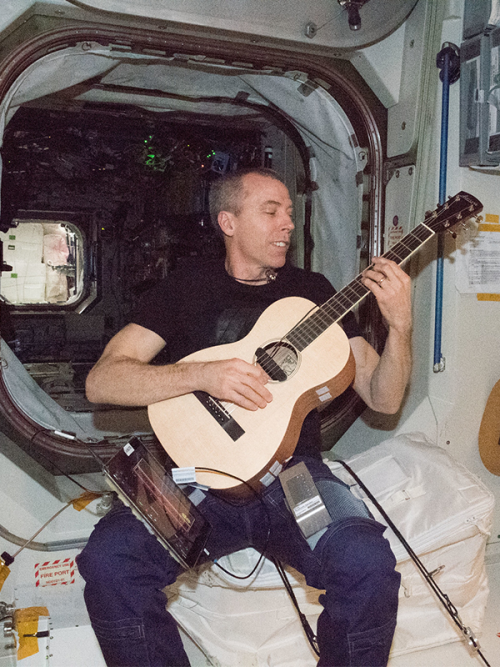
NASA Spotlight: Astronaut Andrew Feustel
Andrew J. Feustel was selected by NASA in 2000. The Lake Orion, Michigan native has a Ph.D. in the Geological Sciences, specializing in Seismology, and is a veteran of three spaceflights. In 2009, Dr. Feustel served on space shuttle mission STS-125. That mission was the fifth and final mission to service the Hubble Space Telescope that improved the observatory’s capabilities through 2014! Feustel most recently served as Commander on the International Space Station from March 21 through October 4, 2018. In his free time, Dr. Feustel enjoys auto restoration, guitar, water and snow skiing and is a fan of automotive and motorcycle racing.
He took some time from his job as a NASA astronaut to answer a few questions about his life and career! Enjoy:
While attending Oakland Community College, you worked as an auto mechanic. How does that job and the skills you learned relate to your job now as an astronaut?

I’ve often told people that I believe having this skillset is almost as important as my training in college and university. I relied on those skills almost every day in space and even on the ground while preparing for missions. That skillset has been really helpful in understanding how to maintain and repair equipment for spaceflight. In general, having those general skills of knowing how things fit together, what the structure is, and how things work, even without knowing anything about the particular item, is very helpful in life.
Has there ever been a time as a NASA Astronaut where you had to overcome self-doubt and if so, how did you?

Yes, probably the most impactful time I had to overcome self-doubt was on my very first mission as a rookie doing a spacewalk for the first time and having to make a repair on the Hubble Space Telescope. Since it was my first spacewalk, I didn’t know if I could do it and didn’t know how I would do. However, I had trained for that mission for three years and the training took over when I started the spacewalk. At that point, I didn’t focus on my self-doubt, I focused on my training and was able to carry out the tasks.
What are you most excited about for the upcoming Artemis Moon missions?
I am most excited about the possibility of humans establishing the ability to live off of our planet. To have the capability to exist on another surface. That, to me, is a start. Humans need that capability for us to live on the Moon then to go to Mars.
What did living in space teach you about community and teamwork?
Not just living in space, but working at NASA and training for space missions taught me a lot about community and teamwork. Living in space allows you to use the skills you learn about teamwork while training. While living in space you must rely on each other for everything. It’s important to recognize the value of working as a team. All of the astronauts have a very different mix of skills and that’s a great thing about the astronaut corps. Being successful and staying alive in space relies on community and teamwork.
What kind of impact did living and working in space have on how you view the Earth?

I am more aware of the fragility of our planet and species which is why humans should extend past the Earth. We are fragile as a planet and the Earth is vulnerable to the impacts of us living here. We cannot have zero impact on the planet, we will always have some impact, but the goal is to lessen the damage that we do to Earth to allow us to live here indefinitely if possible.
What or who inspired you to apply to be an astronaut?

I was inspired by reading the obituary of my great-great uncle. He was very successful in the utilities and railroad industry in the Midwest. Reading about his successes made me believe that I could do anything. I was also interested in space travel from a young age. I believed that I would be involved in the space industry. The motivation of understanding what family members had done before me really encouraged me to reach for my dreams and apply.
What book, movie, or show about space and/or astronauts is the most accurate? The least accurate? You wish was accurate?
I’m less concerned about the accuracy of space and space exploration portrayed in movies, but more interested with the creative thought behind them and I am fascinated with ideas and imagination of the people making these movies. Things portrayed as science fiction in the past become science fact in the future.
What's the most common misconception about astronauts / working at NASA?
The most common misconception about astronauts is that we go on spaceflights often. Over 95% of our job is spent working on the ground. People should come to this job because it’s important to space and space exploration. The job entails so much more than going into space yourself, but the good news is it’s all awesome. I have never been bored at my job. There are so many exciting parts of this work that contribute to NASA missions even if it doesn’t always mean being in space.
Can you share your favorite photo or video that you took in space?

My favorite photo is this one of Michigan and Canada. It captures my life – where I lived and everyone that I know and my family and friends – that’s where I consider home. It’s such a beautiful image.
That’s a wrap! Thank you Dr. Feustel for your time!
Make sure to follow us on Tumblr for your regular dose of space: http://nasa.tumblr.com.
5 Ways NASA Technology is Shaping the Transportation of Tomorrow
We have always been in the transportation business, whether launching astronauts to the Moon or improving airplanes to make them fly faster and safer on less fuel. And whether directly – like more aerodynamic wings for passenger jets – or indirectly – like more comfortable driver seats in sedans – this is yet another way our innovations benefit the public.
Today, the world of transportation is on the brink of some big changes. Drones are poised to make more efficient deliveries, crop surveillance and even disaster relief efforts. Taxis may soon take to the skies as well. And self-driving cars are ever closer to reality.
As we release our latest edition of NASA Spinoff, our yearly publication that celebrates the many ways our technology helps people on Earth, let’s take a closer look at some ways we’re helping augment transportation — and keeping everyone on the roads and in the skies safe.
1. Better data for driverless navigation

If cars are going to drive themselves, they need to be able to “see” and assess the world around them, from other cars to pedestrians and bicyclists to a construction cone in the road. This is accomplished with the help of 3D cameras, or light detection and ranging (lidar), which sends out laser pulses and calculates where obstacles are by how long it takes that laser to bounce back.
But that, says engineer Farzin Amzajerdian at our Langley Research Center, is like building a 3D picture one pixel at a time. Instead, a new kind of lidar grabs a full array of pixels all at once. This “flash lidar” is faster and, because it has fewer moving parts, more reliable. It sailed through initial tests for possible use on a future Moon lander, and our partner has also sold the technology to a major car parts manufacturer, for autonomous cars.
2. Opening the airspace for drones

Air traffic control has largely been a human operation so far, with people in control towers actively directing all 50,000 or so flights daily across the United States. But add in drones, and humans won’t be able to keep up: experts estimate there will soon be millions of aircraft in flight every day.
We’re helping automate and streamline flight control, working with the Federal Aviation Administration (FAA) and private companies to build the new technology needed to manage the anticipated challenges. Among other advances as a result, one company has built a platform used at airports, by air traffic controllers, and by drone operators around the world to more easily file flight plans, view the airspace, get clearance in restricted areas and more.
3. Software modeling for air taxis

It may sound like something from the Jetsons, but real people are imagining the technology needed to make flying taxis a thing. And they’re probably not going to look anything like the passenger planes that we’re used to.
But when you start with a totally new design, there are all sorts of variables, including how much it will weigh. When it comes to flying, weight is a critical factor. For one thing, a heavier craft needs more fuel, but more fuel makes it even heavier. And all that weight stresses the structure, which means reinforcing it (more weight again!). Do it wrong, and all these factors cycle endlessly until you have something too heavy to get off the ground.
New software, designed with our help, generates fast and accurate weight estimates of novel aircraft designs, helping engineers figure out what works and how to make it better. Among other customers? UberElevate, which is trying to take rideshares to the skies.
4. More nimble hand controls

We’ve even played a part in improving different kinds of joysticks, for everything from planes and video games, over the years. We had to because—especially in the early days of space travel—spacesuits were pretty unwieldy under the high g forces of launch and re-entry, so we needed to develop easy-to-use hand controls.
One former astronaut, Scott Parazynski, had acquired a wealth of experience training on and using NASA joysticks for jobs like maneuvering the International Space Station’s robotic arm. He realized similar technology could have even more of an impact on Earth. Parazynski, who is also a medical doctor, envisions improving robotic surgery with the new joystick he created; in the meantime, it’s already on the market for drones, making it easier than ever to use them to record aerial video, inspect a gas pipeline or even assess damage after a hurricane.
5. Helping farmers get the full picture

The “bird’s-eye view” is an expression for a reason: flying overhead provides a perspective you just can’t get with two feet planted on the ground. For the first time ever, we are going to get that bird’s eye view on Mars, and the same expertise that got us there is also giving farmers a new way to keep track of their crops.
The Mars Helicopter is poised to hitch a ride to the Red Planet with our latest rover, Perseverance, later this year. Designing it was a challenge: because there is so little air to provide lift on Mars, we needed something incredibly light (less than four pounds!) with large rotors that spin incredibly fast (nearly 3,000 times per minute).
We teamed up with a company we’ve worked with in the past on high-altitude, solar-powered, unmanned flyers. That company had something else in the works, using the same expertise: a drone equipped with two high-res cameras to capture images of crops as it flies overhead. The data from these images tells farmers where plants are thriving and where they’re not, informing them where they might need more (or less) water or fertilizer.
You can learn more about all these innovations, and dozens more, in the 2020 edition of NASA Spinoff. Read it online or request a limited quantity print copy and we’ll mail it to you!
Make sure to follow us on Tumblr for your regular dose of space: http://nasa.tumblr.com.
On Top of The World – Literally
What’s one perk about applying to #BeAnAstronaut? You’re one step closer to being on top of the world.

Part of the job of a NASA astronaut is a task called spacewalking. Spacewalking refers to any time an astronaut gets out of a vehicle while in space; it is performed for many reasons such as completing repairs outside the International Space Station, conducting science experiments and testing new equipment.

Spacewalking can last anywhere from five to eight hours, and for that reason, astronauts’ spacesuits are more like mini-spacecraft than uniforms! Inside spacesuits, astronauts have the oxygen they need to breathe, water to drink and a bathroom!

Spacesuits also protect astronauts from the extreme environment of space. In Earth orbit, conditions can be as cold as minus 250 degrees Fahrenheit. In the sunlight, they can be as hot as 250 degrees. A spacesuit protects astronauts from those extreme temperatures.

To stay safe during spacewalks, astronauts are tethered to the International Space Station. The tethers, like ropes, are hooked to the astronaut and the space station – ensuring the astronaut does not float away into space.

Spacewalking can be a demanding task. Astronauts can burn anywhere from ~1500-2500 calories during one full assignment. That’s about equal to running 2/3 of a marathon.

Does spacewalking sound like something you’d be interested in? If so, you might want to APPLY to #BeAnAstronaut! Applications are open until March 31. Don’t miss your chance to!

Want to learn more about what it takes to be an astronaut? Or, maybe you just want more epic images. Either way, check out nasa.gov/astronauts for all your NASA astronaut needs!
Make sure to follow us on Tumblr for your regular dose of space: http://nasa.tumblr.com
Cosmic Piece of Pi!
Did you know that pi is involved nearly anywhere you look? We’re not talking about your favorite pastry! Pi (also written as the Greek letter 𝞹, or the number 3.14159...) is an irrational number, which means it can’t be written as a simple fraction like ½. It is the ratio of a circle’s circumference (the distance around its edge) to its diameter (the distance across it) and will always be the same number, regardless of the circle’s size. Here are some places you can find pi in the universe around us!

Our Transiting Exoplanet Survey Satellite, TESS, watches slices of the sky in its hunt for worlds outside our solar system — how many exoplanets are in its night-sky pie? Last July, TESS scientists created a mosaic of 208 images of the southern sky. At that time, it contained 29 confirmed and 1,000 possible exoplanets, and we’re still studying the data to find more. Since this awe-inspiring image is of the southern hemisphere (or half of a 3D circle), there will always be pi! Every slice contains something delicious for scientists to study.

Pi recently played a crucial role in new discoveries about Alpha Draconis, a well-studied pair of stars. After discovering these stars regularly eclipse each other, pi helped scientists learn more about them. Scientists detected the eclipses while monitoring the brightness of Alpha Draconis for periodic dips that could’ve been caused by planets passing between the star and us. Instead of a planet, though, researchers found that its smaller partner in crime was passing in between us and the larger star for about six hours at a time! 💫

Pi comes in handy as we learn more about these two stars. Knowing the percentage of the decrease in Alpha Draconis’ light and the formula for the area of a circle (A=𝞹r2 — or area equals pi times the square of the circle's radius), scientists can predict the sizes of both stars. Because stars typically orbit in an elliptical (or oval) shape, pi also helps scientists use the detection of these eclipses to figure out the orbits of the two stars!
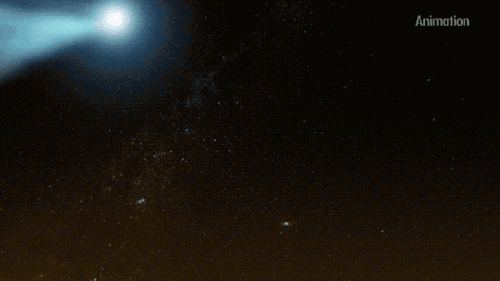
So far we’ve seen pi in many places! But it's also interesting to look at where pi can't be found! We mentioned earlier that many orbit calculations involve pi … but not every one does! Pi does not factor into calculations of hyperbolic orbits — orbits that aren't complete, or don't return to where they started — the same way that it does with elliptical orbits! This is most commonly seen with comets. While many comets orbit normally in our solar system, some oddballs just pass through, like the interstellar ‘Oumuamua that zipped passed us in 2017. ☄️

Perhaps the most popular place you may find pi is in the shape of a typical pie! While NASA’s Fermi Gamma-ray Space Telescope studies gamma-rays, and not blueberries, we think this cool Fermi pie is worth sharing for Pi Day!
Find more ways scientists look up at the night sky and use pi here. And now, don’t be irrational, and go have some pi(e)! 🥧
Make sure to follow us on Tumblr for your regular dose of space: http://nasa.tumblr.com
Weird Magnetic Behavior in Space
In between the planets, stars and other bits of rock and dust, space seems pretty much empty. But the super-spread out matter that is there follows a different set of rules than what we know here on Earth.
For the most part, what we think of as empty space is filled with plasma. Plasma is ionized gas, where electrons have split off from positive ions, creating a sea of charged particles. In most of space, this plasma is so thin and spread out that space is still about a thousand times emptier than the vacuums we can create on Earth. Even still, plasma is often the only thing out there in vast swaths of space — and its unique characteristics mean that it interacts with electric and magnetic fields in complicated ways that we are just beginning to understand.

Five years ago, we launched a quartet of satellites to study one of the most important yet most elusive behaviors of that material in space — a kind of magnetic explosion that had never before been adequately studied up close, called magnetic reconnection. Here are five of the ways the Magnetospheric Multiscale mission (MMS) has helped us study this intriguing magnetic phenomenon.
1. Seeing magnetic explosions up close
Magnetic reconnection is the explosive snapping and forging of magnetic fields, a process that can only happen in plasmas — and it's at the heart of space weather storms that manifest around Earth.
When the Sun launches clouds of solar material — which is also made of plasma — toward Earth, the magnetic field embedded within the material collides with Earth's huge global magnetic field. This sets off magnetic reconnection that injects energy into near-Earth space, triggering a host of effects — induced electric currents that can harm power grids, to changes in the upper atmosphere that can affect satellites, to rains of particles into the atmosphere that can cause the glow of the aurora.

Though scientists had theorized about magnetic reconnection for decades, we'd never had a chance to study it on the small scales at which it occurs. Determining how magnetic reconnection works was one of the key jobs MMS was tasked with — and the mission quickly delivered. Using instruments that measured 100 times faster than previous missions, the MMS observations quickly determined which of several 50-year-old theories about magnetic reconnection were correct. It also showed how the physics of electrons dominates the process — a subject of debate before the launch.
2. Finding explosions in surprising new places
In the five years after launch, MMS made over a thousand trips around Earth, passing through countless magnetic reconnection events. It saw magnetic reconnection where scientists first expected it: at the nose of Earth's magnetic field, and far behind Earth, away from the Sun. But it also found this process in some unexpected places — including a region thought to be too tumultuous for magnetic reconnection to happen.
As solar material speeds away from the Sun in a flow called the solar wind, it piles up as it encounters Earth's magnetic field, creating a turbulent region called the magnetosheath. Scientists had only seen magnetic reconnection happening in relatively calm regions of space, and they weren't sure if this process could even happen in such a chaotic place. But MMS' precise measurements revealed that magnetic reconnection happens even in the magnetosheath.

MMS also spotted magnetic reconnection happening in giant magnetic tubes, leftover from earlier magnetic explosions, and in plasma vortices shaped like ocean waves — based on the mission's observations, it seems magnetic reconnection is virtually ubiquitous in any place where opposing magnetic fields in a plasma meet.
3. How energy is transferred
Magnetic reconnection is one of the major ways that energy is transferred in plasma throughout the universe — and the MMS mission discovered that tiny electrons hold the key to this process.
Electrons in a strong magnetic field usually exhibit a simple behavior: They spin tight spirals along the magnetic field. In a weaker field region, where the direction of the magnetic field reverses, the electrons go freestyle — bouncing and wagging back and forth in a type of movement called Speiser motion.

Flying just 4.5 miles apart, the MMS spacecraft measured what happens in a magnetic field with intermediate strength: These electrons dance a hybrid, meandering motion — spiraling and bouncing about before being ejected from the region. This takes away some of the magnetic field’s energy.
4. Surpassing computer simulations
Before we had direct measurements from the MMS mission, computer simulations were the best tool scientists had to study plasma's unusual magnetic behavior in space. But MMS' data has revealed that these processes are even more surprising than we thought — showing us new electron-scale physics that computer simulations are still trying to catch up with. Having such detailed data has spurred theoretical physicists to rethink their models and understand the specific mechanisms behind magnetic reconnection in unexpected ways.

5. In deep space & nuclear reactions
Although MMS studies plasma near Earth, what we learn helps us understand plasma everywhere. In space, magnetic reconnection happens in explosions on the Sun, in supernovas, and near black holes.
These magnetic explosions also happen on Earth, but only under the most extreme circumstances: for example, in nuclear fusion experiments. MMS' measurements of plasma's behavior are helping scientists better understand and potentially control magnetic reconnection, which may lead to improved nuclear fusion techniques to generate energy more efficiently.

This quartet of spacecraft was originally designed for a two-year mission, and they still have plenty of fuel left — meaning we have the chance to keep uncovering new facets of plasma's intriguing behavior for years to come. Keep up with the latest on the mission at nasa.gov/mms.
Make sure to follow us on Tumblr for your regular dose of space: http://nasa.tumblr.com
The Path to High Adventure Begins With Girl Scouting!

Former NASA astronaut and Girl Scout alumna Jan Davis eating Girl Scout Cookies inside the shuttle Endeavour on Sept. 12, 1992. Image credit: NASA
Leadership, service, being prepared and doing your best – these qualities are exemplified by our astronauts, but are also shared by the Girl Scouts! Our astronaut corps has many scout alumnae, and over the years they’ve been breaking barriers and making names for themselves at NASA.
March 12, 2021 marks the 109th birthday of Girl Scouts in the United States, which has been inspiring generations of girls through leadership and STEM (science, technology, engineering and mathematics) activities to empower the explorers of today and tomorrow. To celebrate, we’re highlighting some of our Girl Scout alumnae over the years!

NASA astronaut and Girl Scout alumna Sunita Williams, who served as an International Space Station commander and spent 322 days in space during two spaceflight expeditions.
Former Scouts have served as crew members on numerous spaceflight missions.

From left: Susan Helms, the first female International Space Station crew member; Eileen Collins, the first woman to pilot and command a space shuttle; and Dr. Kathy Sullivan, the first American woman to perform a spacewalk.
Former Girl Scouts flew on more than one-third of the space shuttle missions and were pioneering forces as women began making their mark on human spaceflight. The first female crew member to serve on the International Space Station, the first to pilot and command a space shuttle and the first American woman to spacewalk were all Scout alumnae.
They continue to break records, such as the first three all-woman spacewalks...

Girl Scout alumnae and NASA astronauts Christina Koch and Jessica Meir made history when they conducted the first ever all-woman spacewalk on Oct.18, 2019. They went on to complete two more spacewalks, successfully completing their task of upgrading the space station’s battery charge/discharge unit. Christina and Jessica’s historic spacewalk was a testament to the growing number of women (and Girl Scouts) joining our astronaut corps; it is a milestone worth celebrating as we look forward to putting the first woman on the Moon with our Artemis Program!
....and the longest spaceflight ever by a woman!

NASA astronaut Christina Koch smiles for a selfie while completing tasks during a spacewalk outside the International Space Station.
Koch went on to seal her name in the record books by surpassing Peggy Whitson’s record for the longest single spaceflight in history by a woman!
Understanding how the human body adjusts to things like weightlessness, radiation and bone-density loss is crucial as we look forward to embarking on long-duration spaceflights to the Moon and Mars. Thanks to former astronaut Scott Kelly’s Year in Space mission, we’ve been able to observe these changes on a biological male. Now, thanks to Christina’s mission, we are able to observe these changes on a biological female.
Girl Scout alumnae will also help lead human exploration farther than ever before as members of our Artemis generation!

From left: NASA astronauts Jessica Watkins, Loral O’Hara and Kayla Barron
On January 10, 2020 we welcomed 11 new astronauts to our ranks – including three Girl Scout alumnae! As part of the first-ever class of astronauts under our Artemis lunar exploration program, Kayla Barron, Jessica Watkins and Loral O’Hara are now qualified for assignments including long-duration missions to the International Space Station, the Moon and Mars.
They took a moment after graduation to share inspiration and insight for current and future Scouts!
Q: A question from the Girl Scouts: What inspires you?
A: “Being a part of an awesome team has always been what inspires me. Whether it’s your Girl Scout troop, a sports team, your class – I think for me always the people around me who push me to succeed and support me when I make mistakes and help me become my best self is what inspires me to show up and do my best.” - NASA astronaut Kayla Barron
Q: How has being a Girl Scout helped you in becoming an astronaut?
A: “Being in the Girl Scouts when I was younger was really cool because, well, first it was just a group of my friends who got to do a lot of different things together. But it really gave us the opportunity to be exposed to a lot of different areas. Like we’d get to go camping. We’d get to ride horses and learn all of these different skills, and so that variety of skill set I think is very applicable to being an astronaut.” - NASA astronaut Loral O’Hara
Q: What would your advice be for the next generation of Girl Scout astronauts?
A: “My advice would be to find something that you’re passionate about. Ideally something in the STEM fields: Science, Technology, Engineering or Mathematics, and to pursue that thing that you’re interested in. Pursue that passion, whatever it is. And don’t give up on your dreams, and continue to follow them until you arrive where you want to be.” - NASA astronaut Jessica Watkins
To all the Girl Scouts out there, keep reaching for the stars because the sky is no longer the limit!
Make sure to follow us on Tumblr for your regular dose of space: http://nasa.tumblr.com